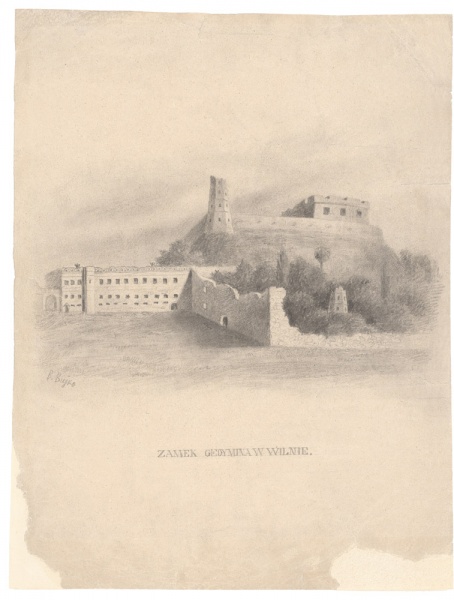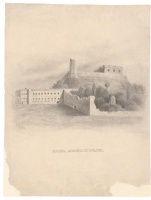
Gediminas’ Castle in Vilnius
| Author: |
Bolesław Buyko (1878–1939)  |
| Created: | late 19th century |
| Material: | paper |
| Technique: | pencil |
| Dimensions: | 31 × 25 cm |
| Signature: | bottom left: B. Bujko; inscription in the middle at the bottom: ZAMEK GEDYMINA W WILNIE. |
The Upper Castle and the Lower Castle, and their role as relics of the glorious past of the Grand Duchy of Lithuania, thrilled the public in the 19th century. Artists depicted their ruins, despite the fact that the Lower Castle was pulled down in 1801, or the fact that the Upper Castle had lost its military importance and had been abandoned as long ago as the 17th century. Both these castles are shown in the drawing Gediminas’ Castle in Vilnius. The ruins of the Upper Castle stand on the hill, and below are the remnants of the Lower Castle, overgrown with trees and contained by a wall. In the middle rises a structure resembling the tower of Gediminas’ Castle. The drawing was based on a lithograph by Ivan Trutnev Ruins of the Upper Castle, reproduced in 1865 in a book by Pompei Batiushkov called Памятники русской старины в западных губернияx (Old Russian Monuments in the Western Provinces). It is an amateur work created by the future painter Boleslaw Buyko (1876–1939) who was a student at the Vilnius School of Drawing at the end of the 19th century. The patriotic youth was interested in the rich heritage of the past, and tried to immortalise its monuments.
Text author Laima Laučkaitė
Source: Law firm Valiunas Ellex art album VILNIUS. TOPOPHILIA I (2014). Compiler and author Laima Laučkaitė, RES PUBLICA (2018). Compiler and author Rūta JanonienėExpositions: “Between presence and memory. Historic images of the Vilnius castles“ 12 October 2023 – 14 January 2024, The National Museum – Palace of the Grand Dukes of Lithuania, curators: Rita Lelekauskaitė-Karlienė, Gabija Tubelevičiūtė, Marijus Uzorka.







